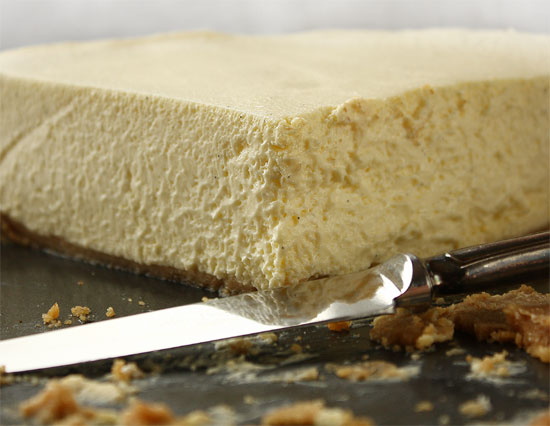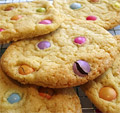It is unusual for O to request a dessert. He’s more of a meat-and-two-veg sort of person really. By some quirk of genetic fate, none of his teeth are of the sweet variety.
I tend to forget this fact when planning a menu for guests and invariably end up asking him, “What should we have for dessert?” His disgusted expression as he then contemplates the various sugary options makes me wonder if perhaps I’d just asked him to choose from a range of particularly gruesome and bloody death scenarios by mistake.
“Should we torture our guests with a red hot poker or serve up their severed heads on the silver platters?”
“Don’t we need the silver platters for the fish course, darling? Perhaps the red hot pokers would save on the washing-up.”
Last weekend however, O surprised me. We were standing in the kitchen discussing the popular choices of pizza toppings in preparation for a dinner with family and friends when I inevitably forgot and asked THE question, “What should we have for dessert?”
“Cheesecake,” he replied.
I was stunned. Here was an endorsement more compelling than that of any celebrity chef. O had just requested cheesecake!
This is how we came to discover Rose’s superb No-Bake Whipped Cream Cheesecake from her latest book, Rose’s Heavenly Cakes.

When I was little and it was the 1970s, cheesecakes were apparently in fashion at dinner parties. I can remember standing on tiptoe to spot the berry-topped creations among the Black Forest Gateaux and cans of squirty cream adorning the dining room table. Seeing the shining cherries and blackcurrants that smothered the entire surface of every cheesecake I saw back then, I naturally assumed these berries were an inescapable part of the tasting experience. I had an intense dislike of forest fruits and therefore refused to sample even the tiniest morsel of a cheesecake.
Then came that fateful dinner party when the hostess, disturbed at the thought of letting a small child go without dessert, remarked that there were some plain cheesecakes still waiting in the kitchen for their toppings. Would I like to try a slice of one of those, without the berries?
I didn’t try just one slice. Falling instantly in love with the smoothness of the filling and the saltiness of the biscuit-crumb base, I ate so many slices that I promptly felt very sick indeed.
My love affair with the cheesecake was swift and cruel. Unable to forget my self-induced nausea, I couldn’t bring myself to eat cheesecake again for at least another ten years.
Perhaps these memories saved me from a similar fate last weekend, for I would certainly have been far less restrained otherwise when serving myself extra slices of Rose’s no-bake cheesecake. A sublime lightness and creaminess elevate this cheesecake way beyond the sum of its parts. And when I tell you that those parts include a crème anglaise made with crème fraîche and an italian meringue laced with fresh lemon juice, you will know how serious I am about this cheesecake.
Of course, O hasn’t become a newly-converted, sweet-toothed fan of all things sugary following his uncharacteristic request. My hidden chocolate bars are still safe unless my secret hideaway is rumbled by my children. Whilst O certainly enjoyed his slice of cheesecake and appreciated its superior qualities, he’s a die-hard lover of cheese in its purest form at heart.

With three wild children and a long-haired cat running through the rooms, our house makes an unlikely dairy for cheesemaking. Scrupulously clean, we are not.
There is one form of cheese that is within our grasp however, and that is ricotta.

Creamy, rich and tangy, ricotta is traditionally made in Italy from the leftover whey after the process of cheesemaking. A simpler option for those with only a kitchen stove at hand is to heat a mixture of whole milk and acid gently until the curds separate from the whey. These can then be easily removed with nothing more technical than a colander and cheesecloth. Indeed, the most challenging part of the whole procedure is in resisting eating all of the warm, milky ricotta within a few minutes of its production.
I don’t think that I left the whey to drain from the curds for quite long enough this time though, which is a shame because I used whole goat’s milk for this ricotta and O was particularly looking forward to it. It was still quite delicious in a runny rather than fluffy sort of way, but you had to catch it quickly before it dribbled over the edges of the oatcakes!

O says that he’d prefer “more goat, less cream” next time, so the challenge has been set. I’ll try not to bore you too much with news of my quest to produce a goat’s milk cheese that satisfies my husband’s exacting standards, but I do feel that I owe it to him as a reward for pushing me towards discovering my new favourite cheesecake recipe.
And his hat was made of good cream cheese …
Creamy Goat’s Milk Ricotta (adapted from a recipe by Julia Moskin)
1 litre whole goat’s milk
250ml double cream
190ml buttermilk
3/4 teaspoon salt
Prepare a sieve or colander lined with a cheesecloth or muslin (folded if necessary) over a large bowl.
Place all the ingredients in a large, heavy-bottomed, non-reactive (stainless steel or enameled – something that won’t react with acid or brine) pot and heat slowly to between 80 and 90 degrees C (175 to 200 degrees F). Stir frequently as the liquid warms but stop stirring once the curds have started separating from the whey.
Remove from the heat and pour into the cheesecloth-lined sieve.
Gather together the ends of the cheesecloth and twist to bring the curds together. Do not squeeze.
Allow to drain for 15 to 30 minutes more and then spoon the ricotta into airtight containers. Refrigerate and use within a week.
Don’t discard the whey! It can be used in many recipes (e.g. pancakes, muffins, sauces) in place of buttermilk or sour cream and will keep for up to a week in the fridge.
Oatcakes (adapted from ‘Scots Cooking‘ by Sue Lawrence)
175g/6oz medium oatmeal
50g/20z pinhead oatmeal
1/2 teaspoon salt
1/4 teaspoon baking powder
25g/10z butter, melted
about 50-75ml/2-3fl oz boiling water
Preheat the oven to 170 degrees C (325 degrees F).
Combine all the ingredients together in a mixing bowl. Add the melted butter and enough boiling water to form a stiff dough when stirred.
Sprinkle some medium oatmeal over a board. Roll out the mixture gently to about 1/4 inch thickness (depending on how thin/thick you like your oatcakes). Use a biscuit cutter to cut out circles of the dough.
Use a spatula to transfer the rounds carefully to a buttered baking tray.
Bake in the oven until just firm (10 to 20 minutes depending on the size of your circles).
Transfer carefully to a wire cooling rack.
Store in an airtight container when completely cooled (you can keep them crisp by storing them buried in porridge oats).








Tes
/ June 15, 2010Those pictures look amazing. I love those recipe, it sounds delicious. Thanks for sharing.
amerrierworld
/ June 15, 2010Thanks, Tes 🙂 I had to be quick to get a photo of the cheesecake – it didn’t hang around for long!
Mallika
/ June 29, 2010Looks absolutely divine. If O doesn’t get a sweet tooth after this, I don’t know what will sway him!
amerrierworld
/ July 2, 2010Well … he did like the biscuit-crumb base … but that was only because it was salty!